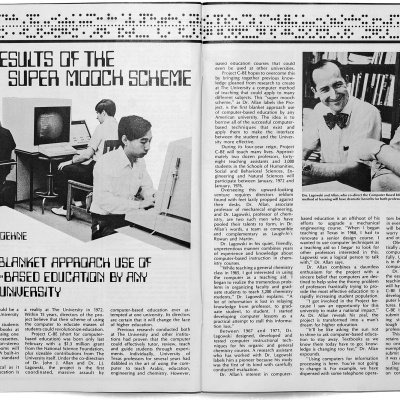New Landmarks Installation Is an Ode to Evolutionary Science

Against a background of subtle, shifting hues and periodic flashes of lightning, branches, twigs, leaves, petals, and feathers fall as air bubbles flow upward. Large, entangled biomorphic shapes roll and undulate in this complex, mesmerizing scene from a world under water—a new environment depicted in artist Jennifer Steinkamp’s latest video project Eon.
Steinkamp, known for her digital work using computer-generated animation, brings these 3D movements to life for the first time in her 30-by-9-foot LED display installation in the newly renovated Welch Hall’s glass façade on Speedway. Eon marks the 45th work commissioned by the university’s public art program, Landmarks, whose collection includes James Turrell’s The Color Inside, Nancy Rubin’s Monochrome for Austin, and José Parlá’s Amistad America.
In her work as a digital artist, Steinkamp explores architecture, nature, and the illusions of time. She is known for her immersive site-specific installations using projections, a medium she describes as being able to “magically transform the architecture with something that’s not physical.” For Eon, however, Steinkamp used LED displays, because of their brightness and ability to exist in rooms with any kind of lighting, allowing for different spatial interventions and experiences.
Andrée Bober, BFA ’92, the director and curator of Landmarks, reached out to Steinkamp in 2018, when the Welch Hall renovation had been underway for three years. Like all of Landmarks’ projects, Steinkamp’s piece took a few years from conception to completion. Eon was a collaborative process where Steinkamp created 3D models of the proposed space and would make adjustments to the piece upon seeing photos of its LED display (no two monitors are calibrated the same). The installation is made up of almost 70,000 pictures across multiple digital layers that involve a careful and meticulous attention to detail necessary for Steinkamp’s simulated natural worlds.
Informed by the research that takes place at the College of Natural Sciences—housed inside Welch Hall—Steinkamp looked at concepts of evolution, focusing on the biological interactions of symbiosis as a key component to how early life began. When Steinkamp, who began integrating nature-based imagery in her work around 2003, speaks about her latest work, she describes it as a “mind-boggling and incredible” creation story that traces the development of life back to bacteria.
Exploring fossil records and early geology, Steinkamp was drawn to the basket star, an echinoderm living in deep sea habitats that regenerates tissue. Inspired by their unique structure—“an organism that looks like a branch swimming around!” she says—she made the basket star “the star of Eon,” grounding the video with multiple large, wreath-like shapes that swim elegantly across the screen.
Steinkamp sought to create her own vision of what the world looked like when life first began, imagining organisms as a cross between plants and animals floating in an aqueous environment. Describing this world as a “balance of forces,” her hyperreal visualizations of numerous biomorphic elements move together in harmony.
Steinkamp describes all of her work as having a “strong feminine sensuality.” In making Eon, Steinkamp says she was appalled to see that almost all the images visualizing evolution were of men, with the classic imagery of ape to man used to depict the emergence of anatomically modern humans. The frustration of not coming across images of female bodies in that context led Steinkamp to arrive at the title of Eon for her new work.
Eon’s feminist undertones are more subtle than her previous works (see Ovaries, 2017). Steinkamp, however, is firm about its sensuality being “definitely female.”
“Evolution might not be,” she says, “but heck, creation sure is!”
Jennifer Steinkamp, Eon, 2020. Video installation.






